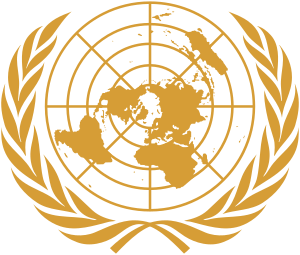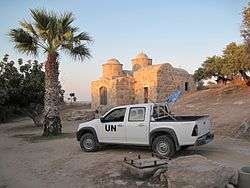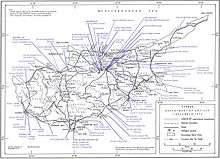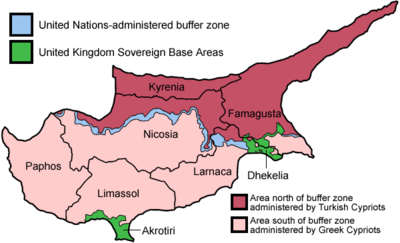United Nations Peacekeeping Force in Cyprus
The United Nations Peacekeeping Force in Cyprus (UNFICYP) is a United Nations peacekeeping force that was established under United Nations Security Council Resolution 186 in 1964 to prevent a recurrence of fighting following intercommunal violence between the Greek Cypriots and Turkish Cypriots, to contribute to the maintenance and restoration of law and order and to facilitate a return to normal conditions.[2] Major General Cheryl Pearce (Australia) is the current Force Commander of UNFICYP, appointed in 2018, and preceded by Major General Mohammad Humayun Kabir (Bangladesh).[3]
 | |
 A UNFICYP patrol in the buffer zone. | |
| Abbreviation | UNFICYP |
|---|---|
| Formation | 1964 |
| Type | Peacekeeping force |
| Legal status | Active |
| Headquarters | Blue Beret Camp, Nicosia International Airport |
Head |
|
Parent organization | Department of Peacekeeping Operations |
| Website | UNFICYP Home page |
Following the 1974 Greek Cypriot coup d'état and the Turkish invasion of Cyprus, the United Nations Security Council extended and expanded the mission to prevent the dispute turning into war, and UNFICYP was redeployed to patrol the United Nations Buffer Zone in Cyprus and assist in the maintenance of the military status quo. Since its establishment, the force has also worked in concert with the Special Representative of the Secretary-General and representatives of the two communities to seek an amicable diplomatic solution to the Cyprus dispute.
Initially, UNFICYP consisted of military and civilian contingents drawn from Australia, Austria, Denmark, Finland, Canada, Sweden, Ireland, New Zealand, and the United Kingdom. However, over its long history the force has been the subject of various UNSC resolutions and reorganisations, and currently comprises contingents from Argentina, Australia, Austria, Bosnia-Herzegovina, Canada, Croatia, El Salvador, Ghana, Hungary, India, Ireland, Italy, Montenegro, the Netherlands, Peru, Serbia, Slovakia, Ukraine and the United Kingdom.
As of 2018, the mission has a strength of 1,009.[4] The mandate for UNFICYP was last renewed on 25 July 2019 and extended until 31 January 2020.[5]
History
| Part of a series on the Cyprus dispute | ||||||||||||
| Cyprus peace process | ||||||||||||
|---|---|---|---|---|---|---|---|---|---|---|---|---|
 | ||||||||||||
|
History
|
||||||||||||
|
Primary concerns
|
||||||||||||
|
Secondary concerns
|
||||||||||||
|
International brokers |
||||||||||||
|
Proposals
|
||||||||||||
|
Projects |
||||||||||||
United Nations Peacekeeping Force in Cyprus (UNFICYP) is a United Nations peacekeeping force that was established under United Nations Security Council Resolution 186 in 1964 to prevent a recurrence of fighting following intercommunal violence between the Greek Cypriots and Turkish Cypriots, to contribute to the maintenance and restoration of law and order and to facilitate a return to normal conditions.[2]
Following the 1974 Greek Cypriot coup d'état and the Turkish invasion of Cyprus, the United Nations Security Council (UNSC) extended and expanded the mission to prevent the dispute turning into war, and UNFICYP was redeployed to patrol the United Nations Buffer Zone in Cyprus and assist in the maintenance of the military status quo. Since its establishment, the force has also worked in concert with the Special Representative of the Secretary-General and representatives of the two communities to seek an amicable diplomatic solution to the Cyprus dispute.
On 5 December 2006, the United Nations Secretary-General Kofi Annan recommended a further six-month extension in the mandate of the UN mission that has been deployed on the island for over four decades. Mr. Annan said that while the situation remained "calm and stable with no major violations of the ceasefire lines," he regretted the continued stalemate in the political process and the "missed opportunities" over the past 10 years.
Deployment
UNFICYP is headquartered from the Blue Beret Camp next to the abandoned airport of Nicosia. The current force commander is Major General Cheryl Pearce, AM (Australia), (UNFICYP) Force Commander of United Nations Peacekeeping Force in Cyprus.[8]
Prior to 1974

Upon UNFICYP's arrival on the island, the national contingents were each assigned a sector, which mostly coincided with the boundaries of the civil districts:[9]
- Paphos District – Austrian contingent
- Lefka District (consisting of the Western part of Nicosia District) – Danish contingent
- Limassol Zone (consisting of Limassol District New Zealand contingent and the Western half of Larnaka District) – British contingent
- Nicosia District – British contingent
- Larnaca Sector (consisting of the Eastern half of Larnaka District) – Irish contingent
- Kyrenia District – Finnish contingent
- Famagusta District – Swedish contingent
When, in October 1973, the Irish contingent was withdrawn from Cyprus in support of the United Nations Emergency Force during the Yom Kippur War, the Austrian contingent was relocated from Paphos District (which was subsequently absorbed by the British contingent) to Larnaca District to replace them, with the Western half, which had previously been patrolled by the British contingent, absorbed into the Austrian sector.[9]
Canada in UNFICYP – From 15 March 1964 to 15 June 1993, Canada maintained a battalion-sized contingent of peace-support troops in UNFICYP. During this period, the Canadian contingent went through 59 rotations and some 25,000 CAF personnel completed six-month tours on the island. With Denmark, Ireland and Finland, Canada was one of the four original contributors of troops to UNFICYP, committed by the government of Prime Minister Lester B. Pearson on 12 March 1964. The lead elements of the initial rotation of the Canadian contingent arrived on 15 March 1964, followed by a brigade headquarters, the 1st Battalion, Royal 22e Régiment, and a Reconnaissance Squadron from The Royal Canadian Dragoons mounted in Ferret scout cars that were transported to Cyprus by HMCS Bonaventure. By 1993, when Canada withdrew its combat arms contingent from UNFICYP, every infantry battalion of the Regular Force had deployed to Cyprus at least once, and Regular Force artillery and armoured regiments had reorganized for infantry duties to take their turns. The current contribution are small numbers of staff officers on one-year rotations. The operation name “Snowgoose” dates from July 1974, when the Canadian contingent in UNFICYP — originally made up of 1 Commando, Canadian Airborne Regiment, and the Airborne Field Squadron (the combat engineer element of the Canadian Airborne Regiment) — was rapidly augmented by 2 Commando and 3 Commando in response to the Turkish invasion of Cyprus that began on 20 July 1974.[10]
Since 1993


As of 31 May 2012, the total strength (military personnel and civilian police) of UNFICYP is 926 individuals. The 858 military personnel are from Argentina, Austria, Brazil, Canada, Chile, China, Croatia, Hungary, Paraguay, Peru, Serbia,[11] Slovakia and the United Kingdom.[12]
On 31 October 2019, Ghana began contributing to the peacekeeping forces in Cyprus.[13]
UNFICYP's military personnel are mostly divided up into national contingents, with each major contingent being responsible for one of the buffer zone's three remaining sectors. The Argentine contingent includes soldiers from the Argentine military forces, including the Argentine Army and the Argentine Marines, as well as from Brazil, Paraguay and Chile; whereas the Slovak contingent includes soldiers from Croatia.[12]
- Sector 1 starts at Kokkina exclave and covers approximately 90 kilometres to Mammari, west of Nicosia. It has been the responsibility of the Argentinian Contingent since October 1993. Sector One Headquarters and Command Company are located in San Martin Camp, which is near Skouriotissa village. Support Company finds its home at Roca Camp, near Xeros in the north. The two line companies composed of 212 troops are deployed along four permanently manned patrol bases while also conducting mobile patrols from the San Martin and Roca camps.[14]
- Sector 2 starts at Mammari, west of Nicosia and covers 30 kilometres to Kaimakli, east of Nicosia. Since 1993, has been the responsibility of the 183-strong British contingent, which deploys using the name Operation TOSCA.[15]
- Sector 4 (the actual 3rd Sector, but because of UNFICYP history still named Sector 4) starts at Kaimakli, east of Nicosia and covers 65 Kilometres to the village of Dhernia, on the east coast of Cyprus. Since 1993, it has been the responsibility of the Slovakian and Hungarian contingent with 202 Soldiers.[16]
In addition to the main sector contingents, there are several other military units under UNFICYP command, including:
- Military Observer Liaison Officers – involved at all levels across the Force in daily negotiations and liaison functions with both opposing forces (OPFOR).[17]
- Force Military Police Unit (FMPU) – one of only two remaining multi-national sub units within UNFICYP, the other being the Mobile Force Reserve. The FMPU is commanded by a major of the UK Royal Military Police (RMP), with 7 other members of the RMP as part of the 25 strong unit. Other contributing nationalities are Argentina (6), Hungary (5) and Slovakia (6).[17]
- Mobile Force Reserve (MFR) – high readiness reserve able to react to any incident anywhere on the island. Formed from the Permanent Force Reserve in 1997, the unit is composed of Argentinean, British, Hungarian and Slovakian peacekeepers, a mix of customs and cultures, where the four different nationalities work together. From 1997 until their departure in 2001 a select contingent of each rotation of Austrian soldiers was part of the MFR. The unit is equipped with Alvis Tactica APCs, which are armed with general-purpose machine guns. The MFR is trained in public order and major incident reaction techniques. In addition the MFR is also trained for air mobile operations using Bell 212 helicopters to rapidly insert into trouble areas.
- The UN Flight (ARGAIR)[18] – the flight is equipped with three helicopters and, since 1994, has been staffed by 28 airmen from the Argentine Air Force.[18] They use Hughes 500 and Bell 212 helicopters and, by 2003, had logged a total of 10,000 flight hours without accident.[19] During the 2006 Israel-Lebanon conflict the Lebanese Prime Minister Fuad Siniora was brought in and out of Lebanon by one of their helicopters.[20]
- Force Engineers – engineering support to UNFICYP is provided by the Integrated Support Services (ISS) and consists of the Chief Engineer (CE), the Force Engineer (FE), the Force Engineer HQ Unit, Support Services Workshop Units, (SSWU) Sector Engineers and Engineering Elements from each contingent.[17]
There are 69 civilian police officers supplied by Australia, Bosnia and Herzegovina, Croatia, El Salvador, India, Ireland, Italy, Montenegro, the Netherlands and Ukraine. In addition, UNFICYP has 147 civilian staff members, 39 of whom were internationally recruited and 108 locally recruited.[12]
Buffer Zone

The United Nations Buffer Zone in Cyprus is a demilitarised zone, patrolled by UNFICYP, that was established in 1974 following the Turkish invasion of Cyprus, and de facto partitions the island into the area controlled by the Government of Cyprus (which is the de jure government for the entire island save for the British Sovereign Base Areas) in the South and that under the administration of the Turkish Republic of North Cyprus in the North. The zone runs for more than 180.5 kilometres (112.2 mi) along what is colloquially known as the Green Line and has an area of 346 square kilometres (134 sq mi).[21]
The zone stretches for 180 km from the western part of near Kato Pyrgos to the east just south of Famagusta. It cuts through the center of the old town of Nicosia, separating the city into southern and northern sections. There is also a buffer zone around the Kokkina exclave in western Cyprus. The width of the zone ranges from 3.3 metres (11 ft) in central Nicosia, to 7.4 kilometres (4.6 mi) at the village of Athienou. There is no buffer zone along the common border between the eastern British Sovereign Base Area and the area under Greek Cypriot or Turkish Cypriot control.
The buffer zone is home to some 10,000 people and there are several villages and farms located within. The village of Pyla is famous for being the only village on Cyprus where Greeks and Turks live side by side. Other villages are Dhenia, Mammari, Athienou and Troulli while Lymbia lies partially within the zone.
Turkish forces built a barrier on the zone's northern side, consisting mainly of barbed-wire fencing, concrete wall segments, watchtowers, anti-tank ditches, and minefields. This line is also referred to as the Attila Line on some maps, named after the Turkish code-name for the 1974 military intervention: Operation Atilla. The closed off zone has become a haven for Cyprus' wildlife, an example of an involuntary park.[22]
Finances
The annual cost for maintaining UNFICYP is estimated at $57,390,000. This includes the voluntary contribution by the Government of Cyprus of one third of the cost of the force and the annual amount of $6,500,000 contributed by the Government of Greece. Turkey does not directly contribute to the force's budget.[12] The operational cost of UNFICYP just during the period from 16 June 1993 to 31 October 2010 was US$2.91 billion.[23]
Removal of UNFICYP from Cyprus
UN Secretary-General Ban Ki-moon reported in 2011 that "Preliminary internal discussions about the UN presence in Cyprus had been initiated" and hinted that "UNFICYP's continued presence on the island could not be taken for granted".[24]
See also
- Cypriot refugees
- Republic of Cyprus
- Turkish Republic of Northern Cyprus
- United Nations High Commissioner for Refugees Representation in Cyprus
References
- https://unficyp.unmissions.org/leadership
- "United Nations Security Council Resolution 186(1964)" (PDF). United Nations. 4 March 1964. Archived from the original (PDF) on 21 April 2012. Retrieved 18 July 2012.
- https://www.un.org/sg/en/content/sg/personnel-appointments/2018-11-08/major-general-cheryl-pearce-australia-force-commander
- https://peacekeeping.un.org/en/mission/unficyp
- "Security Council Renews Mandate of United Nations Peacekeeping Force in Cyprus, Unanimously Adopting Resolution 2483 (2019)" (Press release). New York. 25 July 2019. Retrieved 2 November 2019.
- "UN Peacekeeping Fatalities by Mission and Incident Type" (PDF). United Nations. 30 June 2017. Retrieved 29 July 2017.
- https://unficyp.unmissions.org/about
- "First Case of CoronaVirus in UNFICYP". Daily Cyprus.
- Henn, Francis (2004). A Business of Some Heat: The United Nations Force in Cyprus 1972–74. Pen & Sword Military. ISBN 978-1844150816.
- "SNOWGOOSE | Operations Abroad | National Defence | Canadian Armed Forces". Forces.gc.ca. 20 February 2013. Retrieved 29 March 2017.
- "Srpski mirovnjaci otputovali na Kipar" (in Serbian). Blic Online. 21 October 2010. Retrieved 4 July 2012.
- "UNFICYP Facts and Figures". United Nations Peacekeeping Force in Cyprus. 31 May 2012. Retrieved 4 July 2012.
- "Ghana joins ranks of Troop Contributing Countries to UNFICYP". United Nations. 31 October 2019. Retrieved 2 November 2019.
- "Sector One". UNFICYP. 30 April 2008. Archived from the original on 17 February 2012. Retrieved 4 July 2012.
- "Sector Two". UNFICYP. 30 April 2008. Archived from the original on 17 February 2012. Retrieved 4 July 2012.
- "Sector Four". UNFICYP. 30 April 2008. Archived from the original on 17 February 2012. Retrieved 4 July 2012.
- "Other Key Units". UNFICYP. 30 April 2008. Archived from the original on 17 February 2012. Retrieved 4 July 2012.
- "United Nations Peacekeeping Force in Cyprus" (in Spanish). Argentine Air Force. 8 August 2008. Archived from the original on 7 April 2012. Retrieved 4 July 2012.
- "VII Brigada Aerea". Helis.com.
- "Photo Release: Lebanese Prime Minister Fuad Siniora at Larnaca airport before being flown by UN helicopter to Beirut". UNFICYP. 27 July 2006. Archived from the original on 21 July 2011. Retrieved 13 September 2010.
- "United Nations Peacekeeping Force in Cyprus".
- Stephane Jarraud, Nicolas; Lordos, Alexandros (2012). "Participatory Approaches to Environmental Conflict Resolution in Cyprus". Conflict Resolution Quarterly. 29 (3): 261–281. doi:10.1002/crq.21040.
- "Report of the Secretary-General on the United Nations operation in Cyprus S/2010/605" (PDF). United Nations. 26 November 2010. Archived from the original (PDF) on 3 February 2014. Retrieved 4 July 2012.
- "Our View: UN is stepping up the pressure". Cyprus Mail. 5 March 2011. Archived from the original on 6 March 2011. Retrieved 6 March 2011.
External links
| Wikimedia Commons has media related to United Nations Peacekeeping Force in Cyprus. |